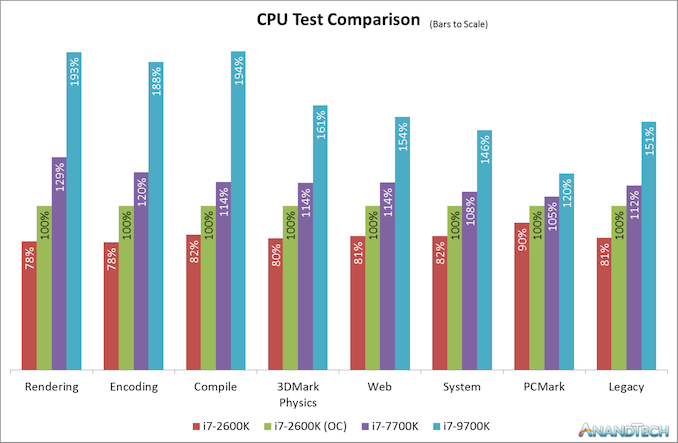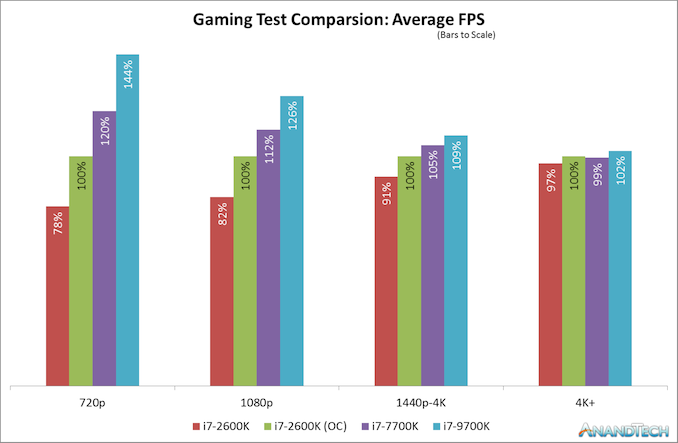Upgrading from an Intel Core i7-2600K: Testing Sandy Bridge in 2019
by Ian Cutress on May 10, 2019 10:30 AM EST- Posted in
- CPUs
- Intel
- Sandy Bridge
- Overclocking
- 7700K
- Coffee Lake
- i7-2600K
- 9700K
Comparing the Quad Cores: CPU Tests
As a straight up comparison between what Intel offered in terms of quad cores, here’s an analysis of all the results for the 2600K, 2600K overclocked, and Intel’s final quad-core with HyperThreading chip for desktop, the 7700K.
On our CPU tests, the Core i7-2600K when overclocked to a 4.7 GHz all-core frequency (and with DDR3-2400 memory) offers anywhere from 10-24% increase in performance against the stock settings with Intel maximum supported frequency memory. Users liked the 2600K because of this – there were sizable gains to be had, and Intel’s immediate replacements to the 2600K didn’t offer the same level of boost or difference in performance.
However, when compared to the Core i7-7700K, Intel’s final quad-core with HyperThreading processor, users were able to get another 8-29% performance on top of that. Depending on the CPU workload, it would be very easy to see how a user could justify getting the latest quad core processor and feeling the benefits for more modern day workloads, such as rendering or encoding, especially given how the gaming market has turned more into a streaming culture. For the more traditional workflows, such as PCMark or our legacy tests, only gains of 5-12% are seen, which is what we would have seen back when some of these newer tests were no longer so relevant.
As for the Core i7-9700K, which has eight full cores and now sits in the spot of Intel’s best Core i7 processor, performance gains are very much more tangible, and almost double in a lot of cases against an overclocked Core i7-2600K (and more than double against one at stock).
The CPU case is clear: Intel’s last quad core with hyperthreading is an obvious upgrade for a 2600K user, even before you overclock it, and the 9700K which is almost the same launch price parity is definitely an easy sell. The gaming side of the equation isn’t so rosy though.
Comparing the Quad Cores: GPU Tests
Modern games today are running at higher resolutions and quality settings than the Core i7-2600K did when it was first launch, as well as new physics features, new APIs, and new gaming engines that can take advantage of the latest advances in CPU instructions as well as CPU-to-GPU connectivity. For our gaming benchmarks, we test with four tests of settings on each game (720p, 1080p, 1440p-4K, and 4K+) using a GTX 1080, which is one of last generations high-end gaming cards, and something that a number of Core i7 users might own for high-end gaming.
When the Core i7-2600K was launched, 1080p gaming was all the rage. I don’t think I purchased a monitor bigger than 1080p until 2012, and before then I was clan gaming on screens that could have been as low as 1366x768. The point here is that with modern games at older resolutions like 1080p, we do see a sizeable gain when the 2600K is overclocked. A 22% gain in frame rates from a 34% overclock sounds more than reasonable to any high-end focused gamer. Intel only managed to improve on that by 12% over the next few years to the Core i7-7700K, relying mostly on frequency gains. It’s not until the 9700K, with more cores and running games that actually know what to do with them, do we see another jump up in performance.
However, all those gains are muted at a higher resolutions setting, such as 1440p. Going from an overclocked 2600K to a brand new 9700K only gives a 9% increase in frame rates for modern games. At an enthusiast 4K setting, the results across the board are almost equal. As resolutions are getting higher, even with modern physics and instructions and APIs, the bulk of the workload is still on the GPU, and even the Core i7-2600K is powerful enough for it. There is the odd title where having the newer chip helps a lot more, but it’s in the minority.
That is, at least on average frame rates. Modern games and modern testing methods now test percentile frame rates, and the results are a little different.
Here the results look a little worse for the Core i7-2600K and a bit better for the Core i7-9700K, but on the whole the broad picture is the same for percentile results as it is for average frame results. In the individual results, we see some odd outliers, such as Ashes of the Singularity which was 15% down on percentiles at 4K for a stock 2600K, but the 9700K was only 6% higher than an overclocked 2600K, but like the average frame rates, it is really title dependent.













213 Comments
View All Comments
Ranger90125 - Tuesday, May 14, 2019 - link
Using a 4790K for years and increasingly disillusioned with Intel's shady practices and lack of progress. Last AMD processor was an Athlon 64 3400 from the glory days of Intel decimated by the competition. Next processor will be 7nm Zen and I look forward to Intel being under the cosh for as long as AMD can manage it. Thanks for a great nostalgic read...I liked the lean and mean Cutress LAN machine :)akyp - Tuesday, May 14, 2019 - link
In less than 5 months my i7-860 will celebrate its 10th birthday. I've been keeping an eye on Ryzen 3 and Navi but never feel the need to upgrade (unless something goes wrong). It doesn't feel any slower than my work-issued i7-6700.curley60 - Tuesday, May 14, 2019 - link
About 5 years ago I went backwards and downgraded(?) my Core i7 2600K to a Gulftown Core i7 990x when they became affordable. The Core i7 990x on my Asus Rampage Formula is running @ 4.660 and is really quite faster in all benchmarks than the Core i7 2600K. Those gulftown processors were ahead of their time. Sure a core i7 7700k is 18% faster in single core work but the 990x destroys it in multi-threaded work. As long as it keeps running I'm going to keep using it with my current GTX 1080ti.Potatooo - Wednesday, May 15, 2019 - link
Would like to see comparisons with a more budget GPU (e.g. 1060/580) and 1080p gaming, probably a more realistic pairing.Bash99 - Wednesday, May 15, 2019 - link
It's wired Handbrake 1.1 hevc 1080p encoding can have 60 fps with x265, even in very fast setting, I can only got 1x fps.rexhab - Thursday, May 16, 2019 - link
I just upgrad from a 5 2500 to a i7 2600K ;) ^^ballsystemlord - Thursday, May 16, 2019 - link
Spelling and grammar corrections:"Sandy Bridge as a whole was a much more dynamic of a beast than anything that's come before it."
Excess "of a":
"Sandy Bridge as a whole was a much more dynamic beast than anything that's come before it."
"They also have AVX2, which draw a lot of power in our power test."
Missing "s":
"They also have AVX2, which draws a lot of power in our power test."
oktat - Sunday, May 19, 2019 - link
would you update the civilization vi ai turn time when technical issues fixed?bullshooter4040 - Wednesday, May 22, 2019 - link
This was a fun article to read through. A great look into the CPU that defined the decade and a wonderful send-off (or not!?!) to the greatest CPU processor since the Core 2 Duo.Up until last year, I had the younger cousin: i5 2500k, which with a lack of hyper-threading, made it much more difficult to keep up in much more CPU intensive tasks (even for a gamer) in 2018 and I made the switch to team orange.
Ryzen is here now, promising longevity, of not just its CPU, but more importantly - the AM4 platform - something that Intel did not accomplish with any of it's processors.
With the Ryzen 3000 series, It's time to jump on board.
PyroHoltz - Thursday, May 30, 2019 - link
NVMe is fully possible on the 2600k gen motherboards, just takes a bit of BIOS modifications to add the appropriate drivers.